If you’ve recently taken the plunge into the world of the Modern Sporting Rifle (MSR), you’ve already figured out that, just in terms of operational mechanics alone, your new rifle is quite a different critter than your conventional semi-auto long guns. And if you haven’t already figured it out, there are many nuances to cleaning and modifying the AR platform compared to other rifle designs. Most veteran shooters of the AR are familiar with these quirks and how to deal with them, but for the newly-minted AR fan, there are some specialized tools that you’ll want on your bench or in your range bag.
Here, we are going to look at five of the most useful tools that you should have for servicing and working on the AR-15 rifle. This is not a complete list, of course, and it doesn’t account for the common items all MSR owners should have, such as punches, hex wrenches, a small hammer, and the usual collection of cleaning equipment. This list does, however, cover the most useful tools every AR-15 owner should have (but the majority don’t) and will use regularly or will need for doing basic component upgrades, such as muzzle swaps, furniture installs, barrel changes, and general maintenance.

Vice Block
Undoubtedly one of the most convenient tools the AR owner can have on his or her work bench is an AR lower receiver vice block. This presumes that you have a bench-mounted vice to work with.
A lower receiver vice block is designed to fit inside the mag well at the top half of the block while the bottom half of the block is secured in a bench vice. This arrangement provides for solid mounting of the work piece (the rifle lower receiver or the completely assembled rifle) so you can perform all manner of service functions—everything from installing a trigger assembly or mounting a new stock to barrel cleaning or installing optics. Any time you need a third arm or comfortable work-height access, the lower receiver vice block will be much appreciated.
Most lower receiver vice blocks are made of one-piece construction, which doesn’t always fit every receiver due to receiver mag well design and dimension variations from manufacturer to manufacturer. One vice that is intended to work with all mag well dimensions is the Real Avid Smart-Fit AR Vice Block. This vice uses an insert that can be adjusted for a precise fit in any AR mag well. It also includes a pivot lock that secures the upper receiver assembly at an angle for easy barrel cleaning.
For those who may wish to do serious work on an upper receiver or barrel assembly, an upper receiver action block is available. Upper receiver vice blocks are two-piece units that are typically hinged and profiled to sandwich the upper receiver between the two halves. The assembly is then secured in a vice. This is a must-have item if you intend to swap barrels or need to adjust your barrel nut torque.

Bolt Carrier Group Cleaning Tool
Fighting carbon fouling buildup on the AR-15 bolt carrier assembly is a never-ending task due to the gas system design. Eventually, if not maintained, carbon buildup can be detrimental to the performance and efficiency of the bolt operation.
To keep the bolt carrier group and its assembly components clean (or mostly clean) of carbon buildup, it is helpful to employ some tools designed specifically for this job. One of the most well-known and commonly used is the C.A.T. M4 tool. This simple device is configured to scrape heavy fouling from the key areas of the bolt carrier group, including the firing pin, bolt, and carrier.

Another nifty tool that performs all these same cleaning functions is the B.O.N.E. Tool from Otis Technology. It’s shaped different than the C.A.T. M4, but also does a great job of scraping carbon from the carrier, bolt, and firing pin. This tool even has an integrated 8-32 threaded hole, allowing it to serve as a T-handle when attached to male 8-32 thread cleaning accessories.

Bore Guide
Most folks don’t really consider using a bore guide when cleaning their AR-15s, which is a shame because this little device not only makes cleaning a rifle bore much easier and less messy, it also goes a long way toward protecting the bore (chamber area and rifling) from repeated scraping and impact from cleaning rods.
A quality bore guide fits into the upper receiver and inserts into the chamber. An O-ring (on most models) provides a good seal to prevent solvents and fouling from being pulled back into the receiver area and making a mess. The bore guide also ensures perfect center-alignment of the cleaning rod and tip with the bore as you run the rod through the barrel, keeping the barrel undamaged. Most also come with a fluid port so you can soak a patch with solvent or lubricant while the patch is in the guide to further reduce cleaning mess.

Bolt Ejector Tool
The bolt ejector is a critical assembly to the proper function of an AR-15. Over time, ejector wear, fouling buildup, a weakened ejector spring, and the need for general cleaning and lubrication of this assembly requires attention. Because the ejector is spring-loaded and retained in the bolt with a pin, assembly and disassembly of these components requires a bolt ejector tool. This is a simple device that eliminates the headache of removing, cleaning, and replacing the bolt ejector assembly from an AR-15 bolt.

Armorer’s Tool
If you plan on doing any serious work on your AR, such as swapping barrels, installing a new handguard system with a different barrel nut, or changing out your buttstock configuration that includes a new buffer tube, then an AR-15 armorer’s tool is a must.
An armorer’s tool includes a buttstock wrench that allows you to remove and install lock nuts when replacing buffer spring tubes for certain stock swaps or to remove and install A2 receiver extensions. It also is used to remove and install A2 muzzle devices, as well as barrel nuts. Due to the many proprietary variations in AR-15 handguard designs (particularly free-float models), it is a good idea to get an armorer’s tool that works with both encapsulated and peg-style barrel nuts. A 1/2-inch drive slot is built into the tool to accommodate a 1/2-inch drive torque wrench to ensure proper torqueing of receiver extension and barrel nuts.
Those are the basic functions of an AR-15 armorer’s tool. Some manufacturers will include a few more features that also come in handy.
As mentioned, there are other basic tools that AR owners need from time to time, and most of these are probably already on-hand. But for complete tooling needs to cover routine maintenance and common modification work, these five tools will make life easy.














